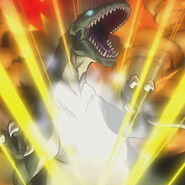Allosauridae is a family of medium to large bipedal, carnivorous allosauroid neotheropod dinosaurs from the Late Jurassic.[2] Allosauridae is a fairly old taxonomic group, having been first named by the American paleontologist Othniel Charles March in 1878.[3] Allosaurids are characterized by an astragalus with a restriction of the ascending process to the lateral part of the bone, a larger medial than lateral condyle, and a horizontal groove across the face of the condyles.[4]
Description[]
Allosaurids have a general anatomy typical of other neotheropod dinosaurs, contributing to the difficulty in defining the family's membership. A typical 8m specimen of Allosaurus fragilis had a skull of about 0.85m. The premaxilla has five teeth and the maxilla usually around 16. The dentary also typically has 16 teeth. All teeth are serrated and continuously replaced throughout the life of the animal. Allosaurid skulls are characterized by two sets of crests formed by the nasal and lacrimal bones respectively. These crests would have been covered by keratin sheathes.[5] The skull also exhibits features consistent with significant cranial kinesis: a synovial joint between the braincase and the frontals and a loose articulation between the dentary and the angular/surangular.[6] This cranial kinesis would have dampened forces on the bones of the skull and allowed allosaurids to open their mouths to very large angles.
Allosaurids have 28 precaudal vertebrae (9 cervical, 14 dorsal, 5 sacral) and an estimated 45-50 caudal vertebrae.[6] Gastralia and ferculae are rarely preserved as fossils but are presumed to occur in all allosaurids[7] The pubis is highly elongated and extends ventrally to form a pubic foot which like in other large dinosaurs is thought to have been used to support the weight of the body in a resting crouch position.[5]
Like most other theropods, allosaurids have very short forelimbs relative to their hindlimbs with three digits on the hand and four on the foot. The first digit of the hand forms a semi-opposable thumb and digits 4 and 5 are absent. Digits 2-4 of the foot are robust but digit 1 is reduced and does not touch the ground and digit 5 is absent.[8] All distal phalanges were capped with large claws, those on the hand were especially long and were curved to facilitate raking and grasping of prey items [5] Phalangeal formulae of the hand and foot are 4-3-4 and 2-3-4-5 respectively.[8]
Gallery[]
References[]
- Jump up^
- Jump up^
- Jump up^ Marsh, Othniel Charles (1878). "Notice of new dinosaurian reptiles". American Journal of Science and Arts. 15: 241–244.
- Jump up^
- ^ Jump up to:a b c Madsen, James H., Jr. (1993) [1976]. Allosaurus fragilis: A Revised Osteology. Utah Geological Survey Bulletin 109 (2nd ed.). Salt Lake City: Utah Geological Survey.
- ^ Jump up to:a b Paul, Gregory S. (1988). Predatory Dinosaurs of the World.
- Jump up^ Chure, Daniel J.; Madsen, James (1996). "On the presence of furculae in some non-maniraptoran theropods". Journal of Vertebrate Paleontology. 16 (3): 573–577. doi:10.1080/02724634.1996.10011341
- ^ Jump up to:a b Gilmore, Charles W. (1920). Osteology of the Carnivorous Dinosauria in the United States National Museum: With Special Reference to the Genera Antrodemus (Allosaurus) and Ceratosaurus. United States National Museum Bulletin Volume 110.







